parkour跑酷简介
- 格式:docx
- 大小:14.14 KB
- 文档页数:5
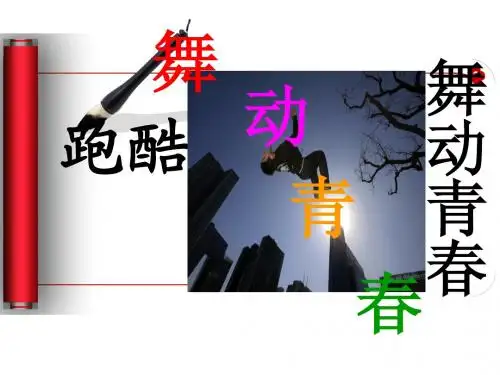
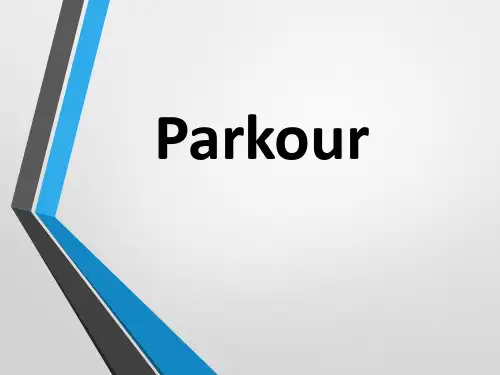
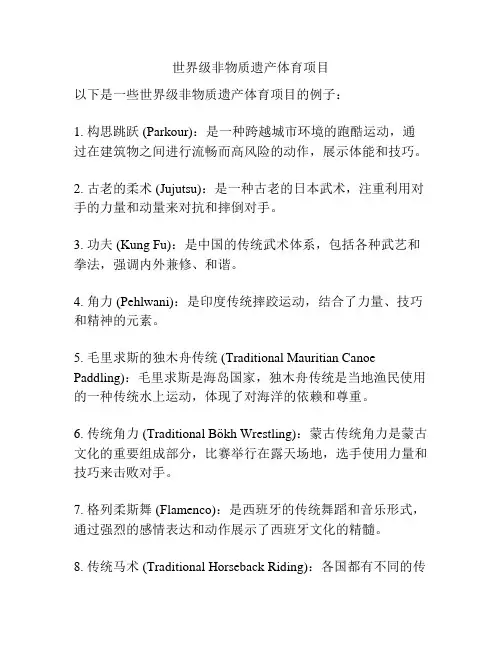
世界级非物质遗产体育项目
以下是一些世界级非物质遗产体育项目的例子:
1. 构思跳跃 (Parkour):是一种跨越城市环境的跑酷运动,通过在建筑物之间进行流畅而高风险的动作,展示体能和技巧。
2. 古老的柔术 (Jujutsu):是一种古老的日本武术,注重利用对手的力量和动量来对抗和摔倒对手。
3. 功夫 (Kung Fu):是中国的传统武术体系,包括各种武艺和拳法,强调内外兼修、和谐。
4. 角力 (Pehlwani):是印度传统摔跤运动,结合了力量、技巧和精神的元素。
5. 毛里求斯的独木舟传统 (Traditional Mauritian Canoe Paddling):毛里求斯是海岛国家,独木舟传统是当地渔民使用的一种传统水上运动,体现了对海洋的依赖和尊重。
6. 传统角力 (Traditional Bökh Wrestling):蒙古传统角力是蒙古文化的重要组成部分,比赛举行在露天场地,选手使用力量和技巧来击败对手。
7. 格列柔斯舞 (Flamenco):是西班牙的传统舞蹈和音乐形式,通过强烈的感情表达和动作展示了西班牙文化的精髓。
8. 传统马术 (Traditional Horseback Riding):各国都有不同的传
统马术形式,如西班牙的战马训练、奥地利的高级马术等。
这些世界级非物质遗产体育项目都具有传统和独特的特点,并且通过代代相传的方式保护和传承。
它们在世界范围内享有广泛的认可和欣赏。
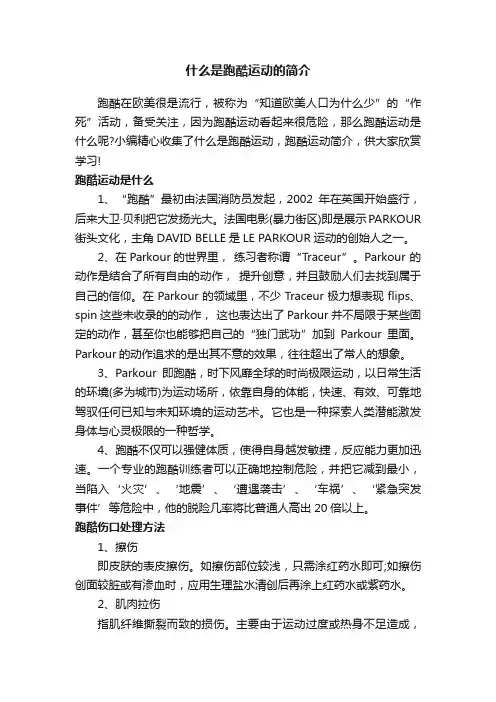
什么是跑酷运动的简介跑酷在欧美很是流行,被称为“知道欧美人口为什么少”的“作死”活动,备受关注,因为跑酷运动看起来很危险,那么跑酷运动是什么呢?小编精心收集了什么是跑酷运动,跑酷运动简介,供大家欣赏学习!跑酷运动是什么1、“跑酷”最初由法国消防员发起,2002年在英国开始盛行,后来大卫·贝利把它发扬光大。
法国电影(暴力街区)即是展示PARKOUR 街头文化,主角DAVID BELLE是LE PARKOUR运动的创始人之一。
2、在Parkour的世界里,练习者称谓“Traceur”。
Parkour 的动作是结合了所有自由的动作,提升创意,并且鼓励人们去找到属于自己的信仰。
在Parkour的领域里,不少Traceur极力想表现flips、spin这些未收录的的动作,这也表达出了Parkour并不局限于某些固定的动作,甚至你也能够把自己的“独门武功”加到Parkour里面。
Parkour的动作追求的是出其不意的效果,往往超出了常人的想象。
3、Parkour即跑酷,时下风靡全球的时尚极限运动,以日常生活的环境(多为城市)为运动场所,依靠自身的体能,快速、有效、可靠地驾驭任何已知与未知环境的运动艺术。
它也是一种探索人类潜能激发身体与心灵极限的一种哲学。
4、跑酷不仅可以强健体质,使得自身越发敏捷,反应能力更加迅速。
一个专业的跑酷训练者可以正确地控制危险,并把它减到最小,当陷入‘火灾’、‘地震’、‘遭遇袭击’、‘车祸’、‘紧急突发事件’等危险中,他的脱险几率将比普通人高出20倍以上。
跑酷伤口处理方法1、擦伤即皮肤的表皮擦伤。
如擦伤部位较浅,只需涂红药水即可;如擦伤创面较脏或有渗血时,应用生理盐水清创后再涂上红药水或紫药水。
2、肌肉拉伤指肌纤维撕裂而致的损伤。
主要由于运动过度或热身不足造成,可根据疼痛程度知道受伤的轻重,一旦出现痛感应立即停止运动,并在痛点敷上冰块或冷毛巾,保持30分钟,以使小血管收缩,减少局部充血、水肿。
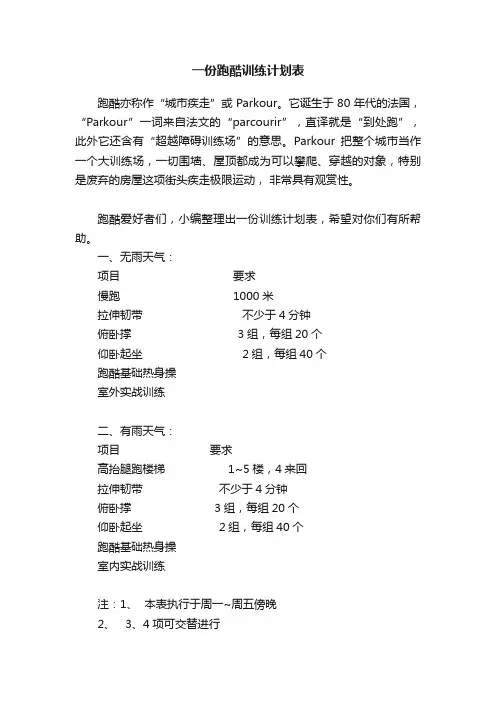
一份跑酷训练计划表
跑酷亦称作“城市疾走”或Parkour。
它诞生于80年代的法国,“Parkour”一词来自法文的“parcourir”,直译就是“到处跑”,此外它还含有“超越障碍训练场”的意思。
Parkour把整个城市当作一个大训练场,一切围墙、屋顶都成为可以攀爬、穿越的对象,特别是废弃的房屋这项街头疾走极限运动,非常具有观赏性。
跑酷爱好者们,小编整理出一份训练计划表,希望对你们有所帮助。
一、无雨天气:
项目要求
慢跑 1000米
拉伸韧带不少于4分钟
俯卧撑 3组,每组20个
仰卧起坐 2组,每组40个
跑酷基础热身操
室外实战训练
二、有雨天气:
项目要求
高抬腿跑楼梯 1~5楼,4来回
拉伸韧带不少于4分钟
俯卧撑 3组,每组20个
仰卧起坐 2组,每组40个
跑酷基础热身操
室内实战训练
注:1、本表执行于周一~周五傍晚
2、 3、4项可交替进行
3、固定每周六下午2:30分进行跑酷动作训练本表具有强制性、固定性、无偿性。
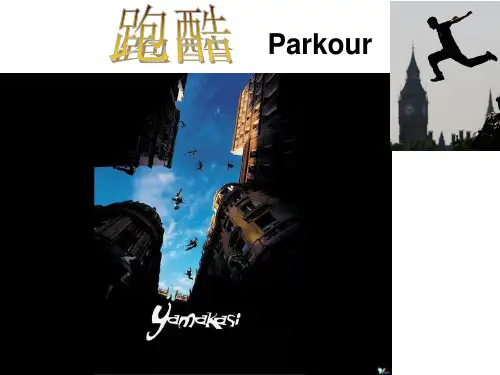
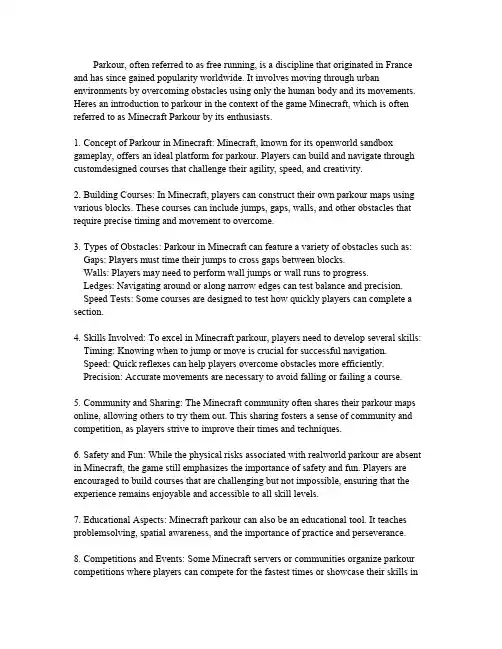
Parkour,often referred to as free running,is a discipline that originated in France and has since gained popularity worldwide.It involves moving through urban environments by overcoming obstacles using only the human body and its movements. Heres an introduction to parkour in the context of the game Minecraft,which is often referred to as Minecraft Parkour by its enthusiasts.1.Concept of Parkour in Minecraft:Minecraft,known for its openworld sandbox gameplay,offers an ideal platform for parkour.Players can build and navigate through customdesigned courses that challenge their agility,speed,and creativity.2.Building Courses:In Minecraft,players can construct their own parkour maps using various blocks.These courses can include jumps,gaps,walls,and other obstacles that require precise timing and movement to overcome.3.Types of Obstacles:Parkour in Minecraft can feature a variety of obstacles such as: Gaps:Players must time their jumps to cross gaps between blocks.Walls:Players may need to perform wall jumps or wall runs to progress. Ledges:Navigating around or along narrow edges can test balance and precision. Speed Tests:Some courses are designed to test how quickly players can complete a section.4.Skills Involved:To excel in Minecraft parkour,players need to develop several skills: Timing:Knowing when to jump or move is crucial for successful navigation. Speed:Quick reflexes can help players overcome obstacles more efficiently. Precision:Accurate movements are necessary to avoid falling or failing a course.munity and Sharing:The Minecraft community often shares their parkour maps online,allowing others to try them out.This sharing fosters a sense of community and competition,as players strive to improve their times and techniques.6.Safety and Fun:While the physical risks associated with realworld parkour are absent in Minecraft,the game still emphasizes the importance of safety and fun.Players are encouraged to build courses that are challenging but not impossible,ensuring that the experience remains enjoyable and accessible to all skill levels.cational Aspects:Minecraft parkour can also be an educational tool.It teaches problemsolving,spatial awareness,and the importance of practice and perseverance.petitions and Events:Some Minecraft servers or communities organize parkour competitions where players can compete for the fastest times or showcase their skills inunique challenges.9.InGame Mechanics:Minecrafts mechanics,such as the ability to build and the physics engine,make it a perfect platform for parkour.Players can use these mechanics to create realistic or fantastical parkour courses.10.Future of Minecraft Parkour:As Minecraft continues to evolve with new updates and features,the possibilities for parkour courses expand.Players can look forward to incorporating new elements into their parkour designs,keeping the game fresh and exciting.In conclusion,Minecraft parkour is a unique blend of creativity,physical challenge,and digital fun,offering players a way to engage with the game in a dynamic and active way.。
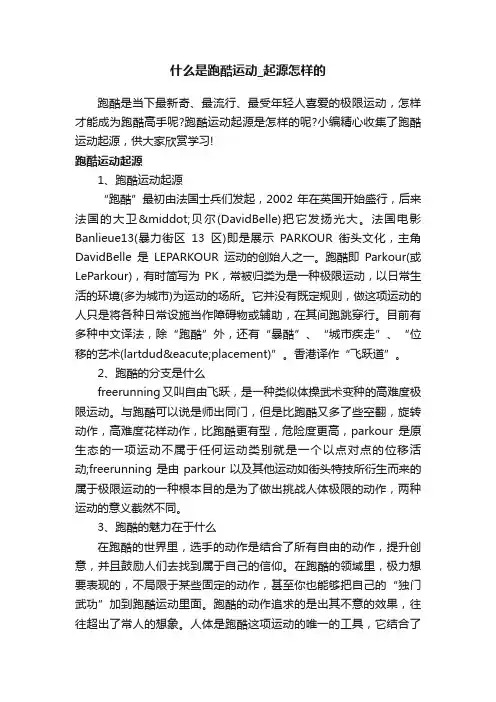
什么是跑酷运动_起源怎样的跑酷是当下最新奇、最流行、最受年轻人喜爱的极限运动,怎样才能成为跑酷高手呢?跑酷运动起源是怎样的呢?小编精心收集了跑酷运动起源,供大家欣赏学习!跑酷运动起源1、跑酷运动起源“跑酷”最初由法国士兵们发起,2002年在英国开始盛行,后来法国的大卫·贝尔(DavidBelle)把它发扬光大。
法国电影Banlieue13(暴力街区13区)即是展示PARKOUR街头文化,主角DavidBelle是LEPARKOUR运动的创始人之一。
跑酷即Parkour(或LeParkour),有时简写为PK,常被归类为是一种极限运动,以日常生活的环境(多为城市)为运动的场所。
它并没有既定规则,做这项运动的人只是将各种日常设施当作障碍物或辅助,在其间跑跳穿行。
目前有多种中文译法,除“跑酷”外,还有“暴酷”、“城市疾走”、“位移的艺术(lartdudéplacement)”。
香港译作“飞跃道”。
2、跑酷的分支是什么freerunning又叫自由飞跃,是一种类似体操武术变种的高难度极限运动。
与跑酷可以说是师出同门,但是比跑酷又多了些空翻,旋转动作,高难度花样动作,比跑酷更有型,危险度更高,parkour是原生态的一项运动不属于任何运动类别就是一个以点对点的位移活动;freerunning是由parkour以及其他运动如街头特技所衍生而来的属于极限运动的一种根本目的是为了做出挑战人体极限的动作,两种运动的意义截然不同。
3、跑酷的魅力在于什么在跑酷的世界里,选手的动作是结合了所有自由的动作,提升创意,并且鼓励人们去找到属于自己的信仰。
在跑酷的领域里,极力想要表现的,不局限于某些固定的动作,甚至你也能够把自己的“独门武功”加到跑酷运动里面。
跑酷的动作追求的是出其不意的效果,往往超出了常人的想象。
人体是跑酷这项运动的唯一的工具,它结合了所有人体的自然能力,比如跑、跳、攀爬等。
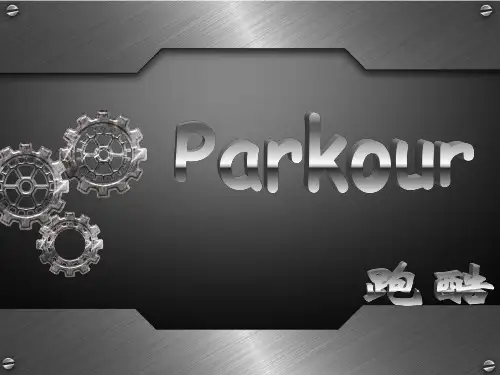
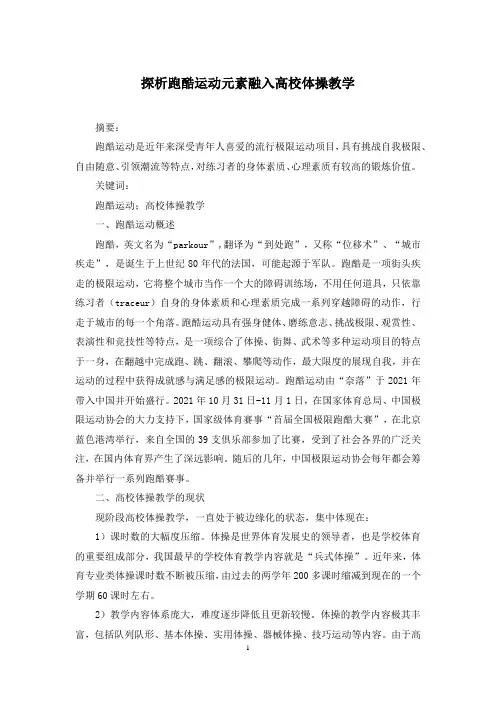
探析跑酷运动元素融入高校体操教学摘要:跑酷运动是近年来深受青年人喜爱的流行极限运动项目,具有挑战自我极限、自由随意、引领潮流等特点,对练习者的身体素质、心理素质有较高的锻炼价值。
关键词:跑酷运动;高校体操教学一、跑酷运动概述跑酷,英文名为“parkour”,翻译为“到处跑”,又称“位移术”、“城市疾走”,是诞生于上世纪80年代的法国,可能起源于军队。
跑酷是一项街头疾走的极限运动,它将整个城市当作一个大的障碍训练场,不用任何道具,只依靠练习者(traceur)自身的身体素质和心理素质完成一系列穿越障碍的动作,行走于城市的每一个角落。
跑酷运动具有强身健体、磨练意志、挑战极限、观赏性、表演性和竞技性等特点,是一项综合了体操、街舞、武术等多种运动项目的特点于一身,在翻越中完成跑、跳、翻滚、攀爬等动作,最大限度的展现自我,并在运动的过程中获得成就感与满足感的极限运动。
跑酷运动由“奈落”于2021年带入中国并开始盛行。
2021年10月31日-11月1日,在国家体育总局、中国极限运动协会的大力支持下,国家级体育赛事“首届全国极限跑酷大赛”,在北京蓝色港湾举行,来自全国的39支俱乐部参加了比赛,受到了社会各界的广泛关注,在国内体育界产生了深远影响。
随后的几年,中国极限运动协会每年都会筹备并举行一系列跑酷赛事。
二、高校体操教学的现状现阶段高校体操教学,一直处于被边缘化的状态,集中体现在:1)课时数的大幅度压缩。
体操是世界体育发展史的领导者,也是学校体育的重要组成部分,我国最早的学校体育教学内容就是“兵式体操”。
近年来,体育专业类体操课时数不断被压缩,由过去的两学年200多课时缩减到现在的一个学期60课时左右。
2)教学内容体系庞大,难度逐步降低且更新较慢。
体操的教学内容极其丰富,包括队列队形、基本体操、实用体操、器械体操、技巧运动等内容。
由于高校体操教学的课时数被不断压缩,已无法承载其原本庞杂的教学内容体系,教师只能从削减教学内容、降低考核标准、控制技术难度等方面来适应体操教学境况的改变,且新的符合体操教学的教学内容(例如:跑酷运动、街舞等新兴项目)不能被吸收到体操教学当中,导致体操教学内容陈旧、教学实施过程浅尝辄止,不能满足学生的学习需求和社会对体操专业人才的需求。

2006年,跑酷由“奈落”(周洪,中国跑酷俱乐部)带入中国,成立中国跑酷官方网站,并在中国推广。
喜欢跑酷的人在中国越来越多。
在中国,葛强被一些Parkour爱好者封为Parkour第一人。
1999年,他以自小练就的飞檐走壁绝技,顺利通过了上海大世界吉尼斯世界总部的审核,被誉为中国飞檐走壁轻功第一人。
Parkour运动类似于轻功,因为很多Parkour的技术在中国武术里是有对应的名称,例如鹞子翻身、横排八步等等。
但另一方面说,Parkour又借用了很多体操动作。
在枫少龙眼中,Parkour应该说是结合了中国功夫、街舞、体操等于一体的运动。
现在喜欢跑酷的人在中国越来越多。
“跑酷”2007年9月在青岛兴起,“兵兵”(网名)等三个年轻人组织了“青岛羽翼社”。
截至目前,社团共有成员20多人,以80后的年轻人为主,他们有的是学生,有的是打工青年,每逢节假日,他们就聚在北岭山一带的废弃工厂或者一浴训练表演。
训练中,难免有伤痛,但这些年轻人都表示,不会因此退缩,在他们眼中,这项运动是一门艺术。
现在青岛关注“跑酷”的年轻人已接近300人。
“跑酷”(Parkour)诞生于上世纪80年代的法国,跑酷运动把整个城市当作一个大训练场,一切围墙、屋顶都成为可以攀爬、穿越的对象。
“Parkour”一词来自法文的“parcour”,有“超越障碍训练场”的意思。
任务和内容1身体协调性很重要,也讲天赋。
如果天生协调性好,那玩起跑酷起步是非常快的,但如果天生就不好,那就有点“麻烦”了,一定得花大工夫好好练练身体协2力量是不可或缺的东西,可以说,力量跟不上的话,永远只能停留在某个台阶而不能进步。
肩部、臂部、背部、腹部,还有下肢的力量,要全面练习3弹跳不是一定必需的素质,但对跑酷有很大帮助4.其实最重要的是,勇气!每个人都有恐惧心理,但事实往往是,越紧张,身子越放不开,越容易受5除了自己战胜心魔之外,还要到类似室内训练馆的地方练习,因为这种地方备有垫子,在练前空翻、后空翻、墙壁翻转时,不容易受伤。
情侣运动日爱的跑酷情侣之间,运动不仅是一种健康的生活方式,更是增进感情的良好途径。
而在众多运动中,跑酷作为一种激动人心的极限运动,正逐渐成为越来越多情侣选择的运动项目。
跑酷的独特魅力和精神内涵,让情侣们在奔跑中感受到彼此的支持与依靠,进一步增进了情感的交流和默契。
本文将为大家介绍情侣运动日爱的跑酷。
跑酷,源自法国“parkour”,指的是在城市、乡村等多种环境中利用身体技巧和环境特点进行自由奔跑和跳跃的一种运动方式。
跑酷融合了体能、技巧和创造力,对运动者的协调性、爆发力和空间感提出了极高的要求。
因此,在跑酷中寻找到跑酷伴侣,一同体验极限的刺激和自由的快感,无疑是情侣间非常浪漫、特别且有趣的选择。
在情侣运动日,爱的跑酷不仅是一种运动,更是一种情感的传递和提升。
首先,情侣们可以共同度过愉快的时光,一同探索城市的街头巷尾,迎接跑酷挑战。
彼此之间的陪伴和支持,让这个过程变得更加充实和有趣。
无论是攀爬、跳跃还是翻滚,都需要情侣之间的默契和配合。
通过刺激的动作,情侣们可以感受到彼此的力量和坚持,进而增进情感的牵引和融合。
其次,在爱的跑酷中,情侣们也可以借此机会共同挑战自我,突破自己的极限。
这种极限的挑战和突破,不仅仅是对身体能力的考验,更是对情侣之间默契和信任的验证。
面对困难和危险,情侣们需要相互携手并肩,相互鼓励和支持,共同克服困难。
这种共同创造成就感和突破感,将为情侣们带来更深层次的情感体验和回忆。
另外,在跑酷的过程中,情侣们也可以欣赏到城市的美景和风情。
无论是高楼林立的城市还是郁郁葱葱的自然风光,都成为情侣们奔跑中的背景和视觉享受。
爱的跑酷不仅可以锻炼身体,也可以让情侣们感受到生活中的美好和多样性。
在奔跑中,虽然需要保持高度的注意力和专注力,但情侣们同样可以欣赏到周围环境的美丽,并将这些美丽与彼此的爱情相融合。
最后,情侣们在爱的跑酷中也可以参加群体赛事,与其他情侣一同竞技、交流和分享。
群体赛事不仅是一次锻炼身体的机会,更是增进情侣之间交流和了解的良好途径。
跑酷,青春的旋舞作者:马骁来源:《神州》2011年第03期在我们身边,有这样一群人,他们不会武功,却能够飞檐走壁,他们不会体操,却能够做出托马斯全旋,他们看起来和你我没有区别,但是他们在向前奔跑的路上,无视任何障碍,跳跃、翻滚、旋转、翻越,仿佛没有什么可以阻挡他们勇往直前的脚步,从不停留。
跑酷,亦称作“城市疾走”,即Parkour(或Le Parkour),有时简写为PK,诞生于20世纪80年代的法国,常被归类为是一种极限运动,以日常生活的环境(多为城市)为运动的场所。
它并没有既定规则,做这项运动的人只是将各种日常设施当做障碍物或辅助,在其间跑跳穿行。
目前有多种中文译法,除“跑酷”外,还有“暴酷”、“城市疾走”、“位移的艺术”。
香港译作“飞跃道”。
parkour这个词的创造人david belle说:在技术上是以最快及最有效的速度及方法越过障碍,在心灵层面上即跨越恐惧,面对困难。
人体是从事这项运动的唯一的工具,它结合了所有人体的自然能力,比如跑、跳、攀爬等。
这是一项能够开发你潜在运动能力的一项体育活动。
无论你在城市,还是在乡村,这项运动要求你都要面对出现在你面前的障碍物,并“挑战它”。
所有这一切的目的就是,决不被障碍物所阻碍,是一项需要真正勇士精神的运动。
跑酷是一项街头疾走极限运动,有点Free-running的意思,它们的区别在于Ree-running更讲求表演,而parkour是速度。
配合猿猴一样的灵活攀越。
不过这项运动的热衷者倒更愿意把它看成是一种青年亚文化所倡导生活方式。
它帮助你只用本身的力量穿越任何障碍物,或到达一个目的地。
跑酷不仅是门运动的艺术,也是一种生活方式,跑跳攀爬中的自由灵魂在运动中无限伸展,这的确是一门艺术。
有人说生命就是危险。
不管我们怎样努力……都逃不过这无情的事实:危险绝不会消失。
风险无处不在。
但我们可以学着去正确地控制危险,并把它减到最小。
因此Parkour所存在的危险性相当大,而所有的Traceur在参与这项运动之前一定要先经过专业的训练。
跑酷——飞跃城市的G点!当你以后再看到对面楼顶有失足青年的时候,就该想想了是否要去报警来挽救他的人生;或者去苦口婆心地用那些“老舅”的道理去说服他,因为他也许会飞身一跃跳到你的面前,一边擦身而过,一边竖起中指对你的无知表示敬意。
跑酷起源原本是那种童年在房上跑来跑去的游戏,可它现在是一项街头疾走极限运动,有点自由狂奔的意思,并不是我们想象中的那种不要命的跳楼,它把整个城市当做一个大训练场,一切围墙、屋顶都成为可以攀爬、穿越的对象,特别是废弃的房屋,更适合飞檐走壁似的速降、跳升和飞跃⋯⋯再配合猿猴一样的灵活攀越,不过这项运动的热衷者倒更愿意把它看成是一种青年亚文化所倡导的生活方式。
跑酷运动和动作追求的是出其不意的效果,往往超出了常人的想象。
法国电影《暴力13街区》即是展示跑酷街头文化,主角David·Belle是跑酷运动的创始人之一。
“跑酷”诞生在80年代的法国,一词来自英文的“parkour”,有“超越障碍训练场”的意思,字母K的使用大约是让这个词看起来更酷吧。
而在2002年在英国开始盛行,随后受到中国年轻一族的追捧。
在跑酷的世界里,练习者称为Traceur。
跑酷是结合了所有自由的动作,提升创意并且鼓励人们去找到属于自己的信仰。
在它的领域里,不少Traceur极力想表现一些跑酷字典里未收录的的动作,这也表达出了跑酷并不局限于某些固定的动作。
甚至说你也能够拿你的动作加入到跑酷里面。
和所有街头文化产物一样,跑酷也有“自由独立“的精神。
它不是要你去做别人不能做的,而是要你去做自己能做的,用最适合自己的动作翻越障碍。
就像创始人大卫所说:做你不能去做的,想你不敢去想的!生活也应该是这样跑酷的。
在里斯,这个创办人小时候常喜欢扮演忍者,在学校的屋顶上跑跑跳跳。
他在“飞跃伦敦”活动提到,我们就是从这里开发出跑酷,整个城镇就好像是我们的一样,像是为了自由狂奔这个运动。
全国极限跑酷大赛浅析作者:刘虓来源:《体育时空》2011年第09期中图分类号:G823 文献标识:A 文章编号:1009-9328(2011)09-000-01摘要跑酷是起源于法国的一项新兴体育运动,在传入中国后得到了快速发展,并拥有了官方认可的全国性比赛。
本文从赛事组织、宣传等方面对两届全国跑酷大赛进行了分析,力图全面反映其概况。
关键词跑酷大赛分析跑酷(Parkour)约于20世纪80年代诞生于法国,是一项仅依靠人体自身最原始的一些运动技能(如攀爬、跑跳)与自然环境的配合来克服自身周围任何障碍物(如墙壁、阶梯)的运动,对人的身心素质都有极高要求。
它不仅是一门移动的艺术,也是跑酷者倡导的一种生活方式。
一、跑酷运动在中国的发展现状作为一项新兴的运动,跑酷在2006年传入中国后的短短几年间就迅速发展壮大。
据统计,至2009年底中国参加跑酷训练的人数已将近10万人,成立了近200家跑酷俱乐部。
2009年9月16日,中国极限运动协会在国家体育总局召开新闻发布会把跑酷运动列为国家体育总局正式比赛项目[1]。
2009年10月底,首届全国极限跑酷大赛在北京蓝色港湾成功举办,并创世界跑酷赛事参加人数最多的跑酷专业比赛。
2011年五一黄金周期间在北京三里屯SOHO举办了第二届红牛极限跑酷大赛。
跑酷在俱乐部、竞赛表演业、娱乐产业上发展迅速,2010年还登上了春晚节目《追梦》,发展前景甚为看好。
二、全国极限跑酷大赛浅析两届全国极限跑酷大赛主办方均为中国极限运动协会,承办方为千百度传播机构。
大赛得到了多方支持,众多国内外知名品牌对大赛提供了赞助,如红牛、特步、PONY等;多家媒体对赛事进行了报道,如:CCTV5、BTV-体育、搜狐、新浪、新华社、中国体育报等。
(一)赛事举办方中国极限运动协会的鼎力支持对中国跑酷的管理和发展来说无疑是最好的后盾。
全国极限跑酷大赛是其最新推出的结合运动、音乐、时尚为一体的新兴体育赛事,它承载着将民间自由、无组织的跑酷运动发展成为正规、有组织的体育项目,并使之能广泛传播,被社会大众所认可的重大使命。
Parkour (Frenc pronunciation: [pa??ku?]) (abbreviated PK), also called as the "art of displacement", [1] is a training discipline that developed out of military obstacle course training.[2][3][4]
Practitioners aim to move from one place to another, negotiating the obstacles in between. The discipline uses no equipment and is non-competitive. A male practitioner is generally called a "traceur", a female a "traceuse".
Developed by Raymond Belle, David Belle, S e bastien Foucan and other members of the original Yamakasi group, parkour became popular in the 1990s and 2000s through a series of documentaries and films featuring these practitioners and others.
History Though S e bastien Foucan statesJiunmp London that "le parkour has always existed, freerunning has always been there, the thing is that no one gave it a name, we didn't put it in the box," the roots of the modern discipline can be traced.
In Western Europe, a forerunner of parkour was French naval officer Georges H before World War I promoted athletic skill based on the models of indigenous tribes he had met in Africa. [11] He noted, "their bodies were splendid, flexible, nimble, skillful, enduring, and resistant but yet they had no other tutor in gymnastics but their lives in nature." [11] His rescue efforts during the 1902 eruption of Mount Pel e e on Saint-Pierre, Martinique, reinforced his belief that athletic skill must be combined with courage and altruism. [11] He bert became a physical education tutor at the college of Reims in France. H "me thode naturelle" (natural method ) session consisting of ten fundamental groups: walking, running, jumping, quadrupedal movement, climbing, balancing, throwing, lifting, [12] self-defense, swimming, which are part of three main forces: During World War I and
World War II, H e bert's teaching continued to expand, becoming the standard system of French military education and training. Thus, H e bert was one of the proponents of "parcours", an obstacle course, [13] which is now standard in military training and which led to the development of civilian fitness trails and confidence courses. [11]
Born in 1939 in what is now Vietnam, Raymond Belle was the son of a French doctor and Vietnamese mother. He was cut off from his parents by the struggle for independence and sent to a military orphanage at the age of 7. Isolated there, he had to become stronger in order to survive. He took it upon himself to train harder and longer than everyone else in order to never be a victim. He would do extra training at night when everyone else was asleep, go for runs, climb trees. He would use the military obstacle courses in secret, but he also created courses of his own that tested his endurance, his strength, his flexibility. Doing this enabled him not only to survive the hardships he experienced during his childhood, but also eventually to thrive. In 1954, he
e bert, wh e bert se returned to France and remained in military education until 1958, when someone who was impressed by his abilities suggested that he join the Paris fire-fighters. [14][15]
In the fire fighters, he made a name for himself as someone who would always go first, always volunteer for the dangerous assignments. When others were still hesitating, he would act. He was involved in many rescues, some dangerous and daring, and received both citations and medals. He also involved himself in athletic pursuits throughout his career and was a French military champion several times in more than one event. After leaving the fire-fighters in 1975, he worked in the private sector, and continued to impress people with his efficiency. [14][15]
David Belle was born in 1973. He was raised by his grandfather, but remained in contact with his father. As a young boy, David was not gifted either physically or academically. He experimented with gymnastics and athletics, but became increasingly disaffected with both school and the sports clubs. As he got older though, he started to read the newspaper clippings that told of his father's exploits and got more and more curious about what had enabled his father to accomplish these feats. Through conversations with his father, he realised that what he really wanted was a means to become truly useful, developing skills that would be useful to him in life, rather than just training to kick a ball or perform moves in a padded, indoor environment. [15][16]